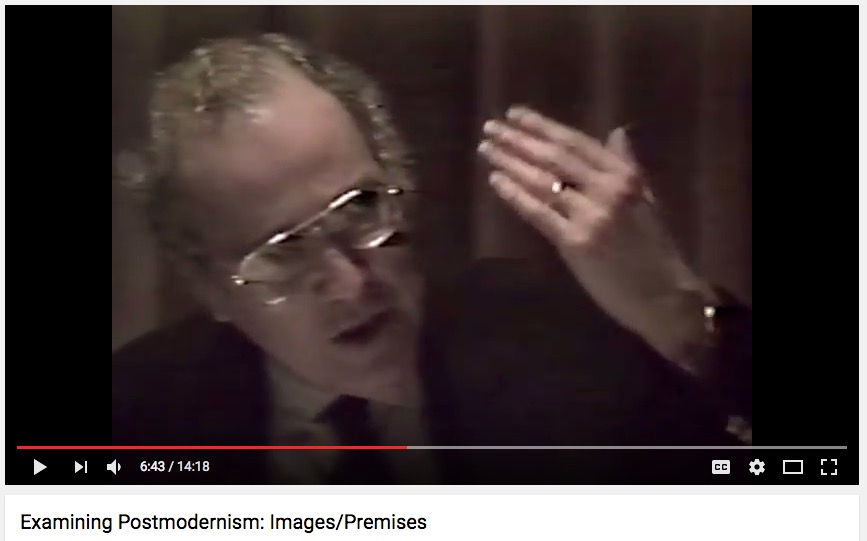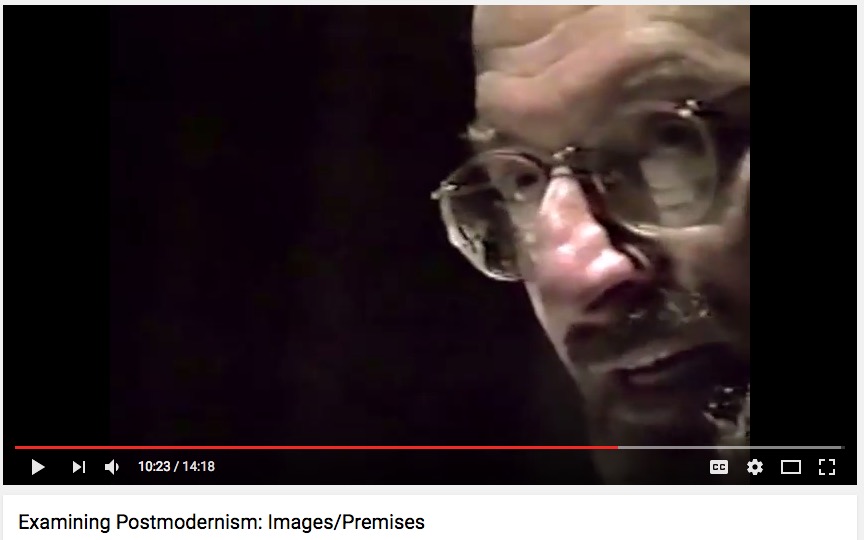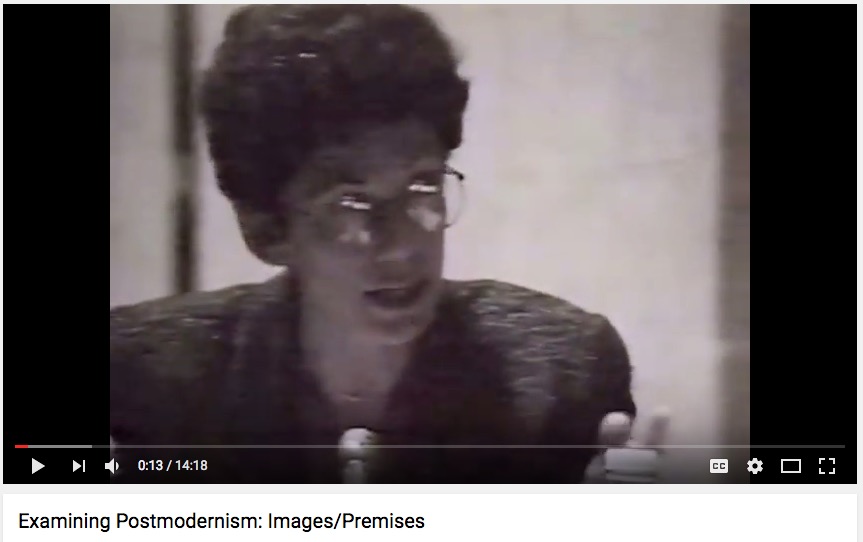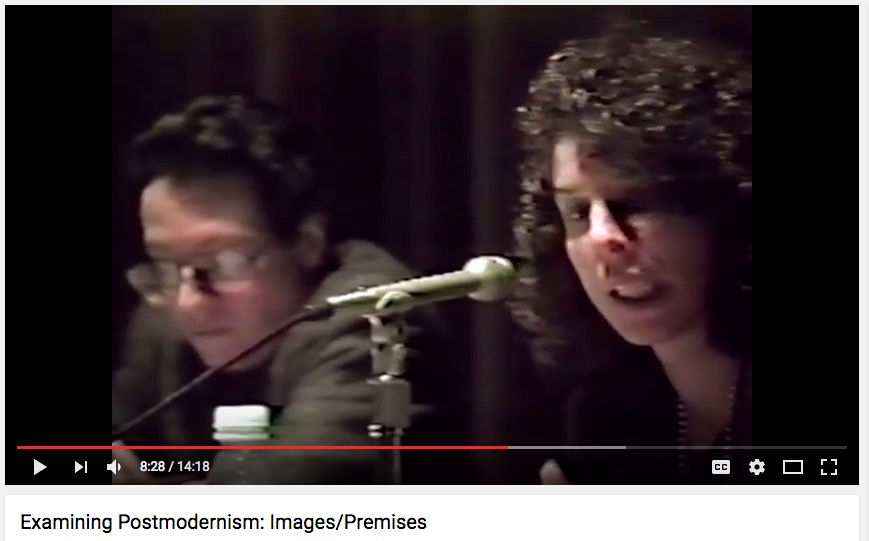 [This is the complete text of a statement made at the first session of the two-evening symposium “Examining Postmodernism: Images/Premises,” sponsored by the Photographic INsight Foundation, organized and moderated by Lynn Stern, and hosted by New York University at NYU’s Tisch Hall on March 5 and 7, 1991. Other panelists: Martin S. Bergmann, Todd Gitlin, Max Kozloff, Donald Kuspit, Shelley Rice. You can watch a 15-minute video excerpt from the first of the panel discussions here; I appear at the beginning of it. — A. D. C.]
[This is the complete text of a statement made at the first session of the two-evening symposium “Examining Postmodernism: Images/Premises,” sponsored by the Photographic INsight Foundation, organized and moderated by Lynn Stern, and hosted by New York University at NYU’s Tisch Hall on March 5 and 7, 1991. Other panelists: Martin S. Bergmann, Todd Gitlin, Max Kozloff, Donald Kuspit, Shelley Rice. You can watch a 15-minute video excerpt from the first of the panel discussions here; I appear at the beginning of it. — A. D. C.]
•
After Postmodernism — What?
In looking for a useful angle from which to approach the issue of postmodernism on this occasion, I’ve concluded that the sociological model might be most fitting. So what I’ll propose to begin with is that we consider the postmodernist moment on two levels: as a manifestation of the sociology of the urban North American art community in the post-Vietnam era, and as an example of the social construction of reality.
My disagreements with postmodernist theory and practice are fundamental, as many of you know. There’s an old joke that says a chicken is just an egg’s way of producing another egg. Much of postmodernist theory boils down to a version of this gag — the notion that the individual is just culture’s way of perpetuating itself. My problem with that theory is that it’s fundamentally deterministic — not only deeply pessimistic but even fatalistic. One of modernism’s faults, according to postmodern theory, was that it was optimistic: modernism believed in itself, in progress, and thus in the future. Post-modernism believes we are doomed to an endless present of continual re-runs — it is thus a kind of TV Guide for the permanent summer of western civ in its decline.
Theory, of course, is meant only to enrich praxis, not to dictate it. Once you begin to take theory as prescription, and to conform all praxis to it, you’re in dangerous waters — for praxis then loses its informative relationship to theory, and thus its vitality. Because it is profoundly defeatist, postmodernist theory in particular seems to generate work that is uninteresting to look at, even for those who produce it and those who champion it critically. This fact can be verified by reading virtually any artist’s statement of purpose or any favorable critical essay on any body of postmodernist work, in which you will be hard-pressed to discover even the most cursory discussion of the physical characteristics or process of manufacture of the work in question.
Why would a generation of artists and critics collaborate on the construction of such a theory-driven, affectless collective corpus? My speculations lead me to propose that this is nurture rather than nature at work. It is a given that postmodernist art is the product of a generation raised from infancy on television. That generation’s members have been subjected to Madison Avenue marketing techniques from the moment their parents first set them down in front of the TV set — blatantly on the commercial channels, more insidiously on public television, especially that most perverse and malignant of all programs aimed at children, “Sesame Street” and its spinoffs.
The statistics vary, but conservative estimates suggest that the average member of this cohort will have watched some 20,000 hours of television by the time they reach the voting age of 18. The number of images that will have been jammed through their pupils by then is incalculable.
Overstimulated visually by the demonstrably addictive kinetic flicker of the video screen, they have been bombarded simultaneously with persistent low doses of radiation. What effect this torture has had on their physical and perceptual systems is not yet clear; that it has damaged them psychologically seems highly probable. Compounding this, both literally and metaphorically they’ve been raised on a diet of non-nutritional junk foods laced with inadequately tested and often toxic chemical additives. In addition, as a result of this culturally ratified brainwashing technique, they have been addicted since childhood to massive doses of sugar, salt, caffeine, and, in many cases, nicotine and alcohol — and, indeed, to the general concept of consumption for its own sake.
Intellectually and emotionally, they are aware that they were identified and manipulated as “markets” before they could speak their native tongue. They have seen members of their own cohort, well below the age of consent, forced or enticed into unspeakable, shameless public acts of mass merchandising — the socially approved version of “kiddie porn.” And they have known from experience, before they entered puberty, that there was no individual or collective experience, ritual, emotion, idea, or achievement that the dominant culture would not gleefully pervert for profit — or just for the sheer hell of it.
Sociologically speaking, what kind of art might we reasonably expect the artists among such a generation of guinea pigs to produce? What kind of world view, what “reality,” might we expect them to construct consensually among themselves?
Considering these questions is certainly more provocative than looking at most of the art they’ve produced. I don’t think that’s any accident. This art is not meant to offer any rewards to anybody save its makers and their merchandisers — and even to them it provides only money and celebrity. It offers the audience a predictable variety of styles but threatens no substantial change in the way things are — true “blows against the empire” won’t be found wearing high price tags in commercial galleries. It mocks the very idea of creativity and individuality, and evidences no concern whatsoever with the spiritual. It is thus an exact mirror of the dominant culture from which it springs. If a culture gets the art it deserves — and I believe that to be true — then this angry, pathetic, lame excuse for art is exactly what North America has got coming to it at this historical moment.
And what else do we have any right to expect from a generation that’s been force-fed millions of images than that they would spend the best years of their lives regurgitating? If — their theories notwithstanding — they do have authentic selves, then such purgation is the necessary first step in locating those identities. If not, then — like Cindy Sherman in one of her most unsettling images — they will lie in their own mess, their vomit clear evidence that what they were fed was poisonous, or at least did not contain the nourishment they needed.
No matter how pampered and groomed, how sleek and well-fed they appear to us superficially, can we fail to understand why, when we ask these starvelings to make art that might nourish us, they not only “prefer not to” (like Melville’s Bartleby the scrivener) but couldn’t possibly do so — even if they wanted to with all their hearts?
•
[First published as “Letter from New York: After Postmodernism, What?” in the December 2012/January 2013 issue of Hotshoe, from the U.K.]
•
This post supported by a donation from Tim Greyhavens.
•
 Special offer: If you want me to either continue pursuing a particular subject or give you a break and (for one post) write on a topic — my choice — other than the current main story, make a donation of $50 via the PayPal widget below, indicating your preference in a note accompanying your donation. I’ll credit you as that new post’s sponsor, and link to a website of your choosing. Include a note with your snail-mail address (or email it to me separately) for a free signed copy of my 1995 book Critical Focus!
Special offer: If you want me to either continue pursuing a particular subject or give you a break and (for one post) write on a topic — my choice — other than the current main story, make a donation of $50 via the PayPal widget below, indicating your preference in a note accompanying your donation. I’ll credit you as that new post’s sponsor, and link to a website of your choosing. Include a note with your snail-mail address (or email it to me separately) for a free signed copy of my 1995 book Critical Focus!
 As a bonus, I’ll include a copy of The Silent Strength of Liu Xia, the catalog of the 2012-13 touring exhibition of photos by the dissident Chinese photographer, artist, and poet, currently in her sixth year of extralegal house arrest in Beijing. The only publication of her photographic work, it includes all 26 images in the exhibition, plus another 14 from the same series, along with essays by Guy Sorman, Andrew Nathan, and Cui Weiping, professor at the Beijing Film Academy.
As a bonus, I’ll include a copy of The Silent Strength of Liu Xia, the catalog of the 2012-13 touring exhibition of photos by the dissident Chinese photographer, artist, and poet, currently in her sixth year of extralegal house arrest in Beijing. The only publication of her photographic work, it includes all 26 images in the exhibition, plus another 14 from the same series, along with essays by Guy Sorman, Andrew Nathan, and Cui Weiping, professor at the Beijing Film Academy.












Post-post Modernism, of course.
Or Neo-Primitivism.
Frankly, it sounds like excessive branding of an entire generation, especially the last paragraph. I am of your generation (83 yrs.) and not affected by Sesame Street (which I do love now that I’ve seen it with my children and grandchildren). I probably do not really understand what post-modernism is (or was?), but I do know that every generation since 1839 has produced great photography and crap, and everything in-between, regardless of the then-topical fashions and isms.
As for the short video production, it was crap. I don’t know who photographed it, but the extreme close-ups were off-putting. A touch of wide angle would have ben relaxing. The sound was a very bad. Which was a mixed blessing, because what I understood seemed like nonsense.
Since I and the other panelists spoke specifically about the cohort of artists who actively embraced postmodernist theory during that period, I don’t see how my comments constitute “excessive branding of an entire generation.”
Of course other artists in all media did other things, but I have never seen so many drawn at the same time to a specific cluster of ideas. Nor have I ever witnessed, before or since, a support system — including the academic world and the critical environment — so thoroughly taken over by a particular ideology.
If I did “not really understand what post-modernism is (or was?),” I would consider myself disqualified from commenting on it — excessive modesty, I’m sure.
I’ve never seen the entire video of this event by Lee Ryder, so I don’t know if it exists in edited form or simply as raw footage from which he apparently drew this extract. Its technical quality notwithstanding, it provides a trace of the event, and I linked to it as such, as is my wont.
From “The 2017 Whitney Biennial Is the Most Politically Charged in Decades,” by Jerry Saltz, in Vulture:
“..there aren’t any self-cannibalizing theories or academic clubs beating you on wall labels. There’s almost no art here based on pop culture or mainstream fashion and design, and you won’t find high production values or ideas of a postmodern theory and identity as a matrix formed by many different texts (all of which have been staples of the last 35 years, and suddenly staid seeming). Not one essay quotes any of the usual postmodern theoretical suspects for authority. Indeed, these curators risk getting kicked off Theory Island in their essays talking about “earnestness, honesty, not being ironic but being sincere, spirituality, personhood, intimate relationships, not being motivated by careers, and a certain modesty or humility.” One even quotes Emerson. Take it from someone who’s spent accumulated alienated months trying to read densely worded wall labels and heady essays, these biennial cattle calls don’t usually roll this way. I love it.”
Evidently, you’re not alone:
Thank you, Allan, for taking the time to provide a refreshing reminder that indeed the glass is half full!
Errol Sawyer (73yrs old)